Paddle Board Tricks: Master Balance and Skill
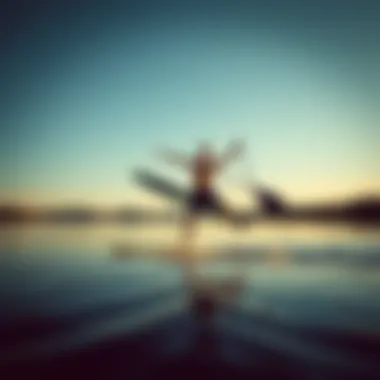
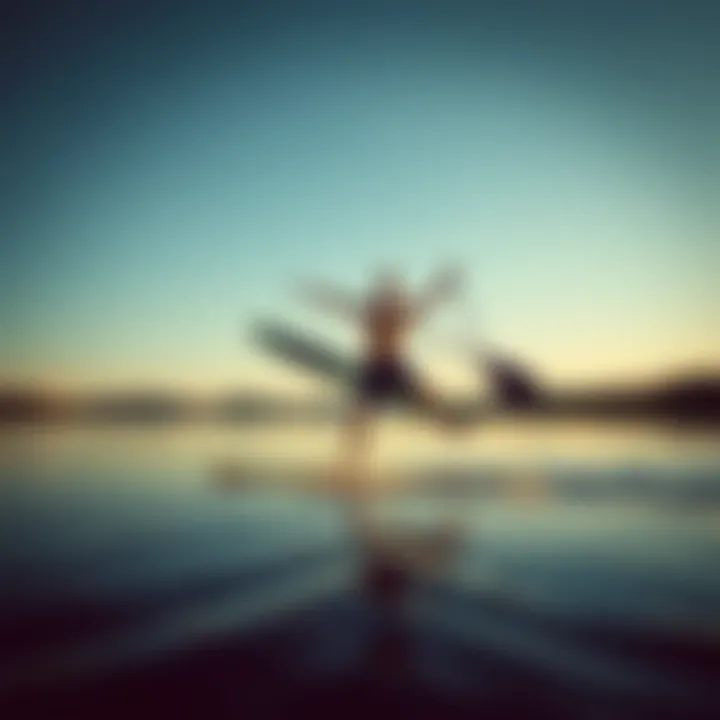
Intro
Paddle boarding has grown immensely in popularity, turning tranquil waters into a vibrant playground for enthusiasts. Whether you’re navigating a calm lake at sunrise or riding the gentle waves at the beach, the art of paddle boarding combines balance, skill, and a love of nature. The thrill of mastering various paddle board tricks not only enhances your experience but also deepens your connection to the water. This article takes you through the intricate world of paddle board tricks, offering techniques, safety guidelines, and gear essentials—helping both beginners and seasoned riders elevate their skills.
Water Activity Overview
Paddle boarding is just one slice of the vast array of water activities that can be enjoyed, each appealing to different tastes. Let’s dive into a brief overview of various water sports that might pique your interest:
Surfing
Surfing, often where many water sports aficionados begin, demands a knack for reading waves and a deep understanding of ocean currents. Riders paddle out to catch the perfect wave, balancing on a board while maneuvering across the face of the surf. This sport requires skill, focus, and a willingness to take a tumble now and again.
Sailing
For those with a penchant for adventure on the high seas, sailing can be a serene yet exhilarating option. Harnessing the wind offers a unique experience compared to paddling, where the pursuit of the perfect wind becomes the ultimate goal. It is about strategy, patience, and seizing the right moments just like in paddle boarding.
Snorkeling
Among the water activities, snorkeling invites participants to float above vibrant marine life while peering down through crystal-clear waters. It’s less about balance and more about exploration as you take in the astonishing underwater scenery.
Paddleboarding
Paddleboarding, our core subject, stands out by merging tranquility and challenge. While it is relatively easy to pick up for beginners, mastering tricks takes dedication and creativity. The thrill lies in gliding across the water, feeling the board respond as you execute turns, spins, or even yoga poses. This flexibility is what makes paddle boarding so appealing—it can be as relaxing or as challenging as you wish.
Tips and Techniques
If you’re just starting or seeking to improve your skills, here are some pointers tailored to your level:
Tips for Beginners
- Start in Calm Waters: Begin on a flat, calm lake or a quiet beach to build confidence.
- Practice Balance: Try different stances—kneeling, sitting, or standing—to find what feels right.
- Use the Right Paddle: Ensure your paddle is the right length; generally, it should be about 6-8 inches taller than you.
Advanced Techniques for Experienced Enthusiasts
As you gain proficiency, consider integrating these more complex tricks into your repertoire:
- No-Handed Balancing: Transition to a no-hand stance, testing your core strength and control.
- Board Spinning: Incorporate a spin when you’re comfortable with basic turns to impress fellow paddlers.
- Yoga Moves: Stretching on the board can enhance balance and stability; poses like Warrior or Downward Dog can elevate your practice.
Safety Guidelines
Safety remains paramount in all water activities:
- Always Wear a Life Jacket: Regardless of skill level, safety gear is critical.
- Know the Weather Conditions: Pay attention to winds and currents before heading out.
- Stay Within Your Skill Level: Avoid biting off more than you can chew; build on your skills gradually.
Gear Reviews
Choosing the right equipment is essential for mastering paddle board tricks. Consider the following gear:
- Paddleboards: Look for versatile boards suitable for both flat and choppy waters. Brands like Starboard and BIC are popular choices.
- Paddles: Carbon paddles might be pricier, but they often offer better performance and reduced fatigue during long sessions.
- Wetsuits: Essential for colder waters, a decent wetsuit helps keep you warm while permitting range of motion.
Destination Guides
Here are some suggestions for ideal locations to practice your paddle board skills:
Popular Water Sports Locations
- Hanauma Bay, Hawaii: Great for stunning marine life and calm waters.
- Lake Tahoe, California: Offers breathtaking views and diverse paddling experiences.
Hidden Gems for Water Enthusiasts
- Secret Lagoon, Iceland: A tranquil location with surreal landscapes.
- Cocoa Beach, Florida: Not only vibrant beaches but also a friendly community of paddlers.
Travel Tips for Water Sports Trips
- Book Off-Peak: If possible, plan your trip during less crowded times for a more peaceful experience.
- Research Local Regulations: Ensure you are familiar with local laws regarding paddle boarding, including permits or required safety gear.
Paddle boarding isn’t just about balance; it’s about enjoying the journey and embracing the challenge that comes with mastering new tricks. With practice, patience, and the right gear, you’ll find that you’re not just gliding on water, but conquering it. Embrace the adventure and let each session uncover more about your capabilities.
Prologue to Paddle Boarding
Paddle boarding is more than just a recreational activity. It's a way to connect with nature, engage in fitness, and cultivate skills that can be both challenging and exhilarating. As the popularity of this sport has surged, many enthusiasts are discovering the art behind balancing and maneuvering on the water. This section sets the stage for understanding the intricacies of paddle boarding, emphasizing its history and foundational techniques.
History and Evolution of Paddle Boarding
Paddle boarding, with its roots dating back to ancient Polynesia, has undergone significant changes over the years. Initially, it was a means of transportation and fishing for island dwellers. Today, it has morphed into a widely practiced sport enjoyed across the globe. The transformation truly kicked off in the 1950s when surf instructors in Hawaii started using large boards to teach surfing techniques. This practice paved the way for modern paddle boarding as we see it today, combining surfing, kayaking, and fun on flat water.
Now, paddle boarding comes in various types tailored for surfing, racing, and even yoga. This evolution mirrors the growing interest in water sports and offers a plethora of experiences for enthusiasts of all levels. The diversity in types of paddle boards also means that whether you're in the calm waters of a lake or navigating the waves at the beach, there's a suitable board for you.
Understanding the Basics of Paddle Boarding
Before diving into the tricks that can wow onlookers or enhance performance, it’s crucial to grasp the basic principles. Mastering paddle boarding starts with understanding your equipment. The paddle board you choose can make or break your experience. You'll find different shapes and sizes, each serving distinct purposes. Beginners often benefit from wider boards, which provide greater stability, while experienced paddlers might prefer narrower boards for speed and agility.
Key elements to consider include:
- Paddle Length: Ensure it’s appropriate for your height; it can significantly affect your paddling efficiency.
- Board Type: As discussed, whether it's a performance board or a leisurely one makes a big difference.
- Posture and Stance: Start by standing tall, with feet shoulder-width apart and knees slightly bent. Good posture enhances balance and control.

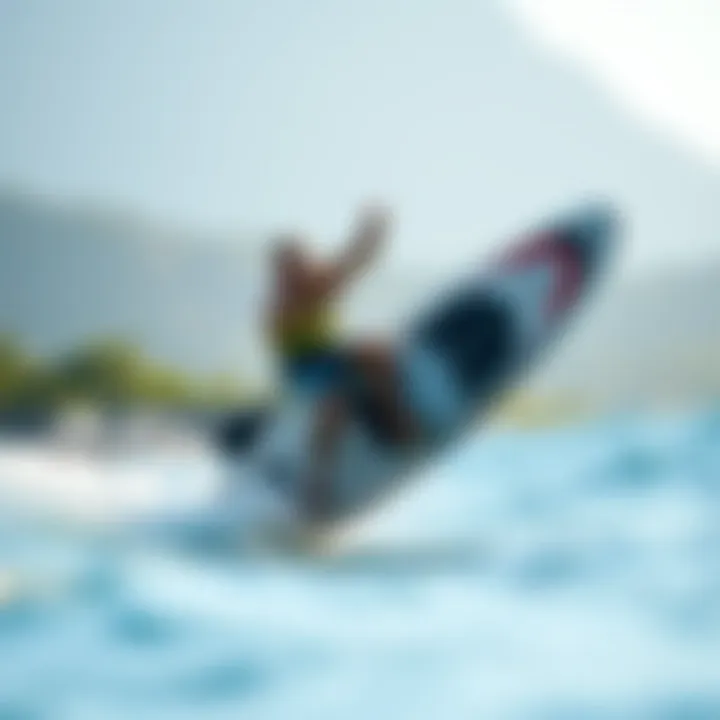
"The balance a paddle boarder achieves is not merely about standing upright; it is a dynamic relationship with the water beneath them."
To this end, practicing on calm waters helps to build confidence and technique. With the right understanding of gear and a few basic skills, you're well on your way to exploring the advanced tricks that paddle boarding has to offer. It’s about establishing a solid foundation before soaring to greater heights.
In sum, paddle boarding invites individuals to embrace an adventure that combines history, technique, and personal growth on the water. Understanding its evolution and mastering the basics form the groundwork for further exploration into more complex maneuvers and performance improvement.
The Importance of Balance in Paddle Boarding
Balance isn't just a buzzword in paddle boarding; it’s the very foundation that holds everything together. Without it, or using it poorly, even the most advanced paddle board trick can turn into a face-plant in the water. When you're out on a board, it’s crucial to maintain stability, as it influences not only your ability to maneuver but also your enjoyment of the sport. Here, we delve into why balance matters so much in paddle boarding and examine the elements that underpin this critical skill.
Core Strength and Stability
At the core of stability in paddle boarding lies core strength. Think of your core as the trunk of a tree; if it’s weak, the branches—your arms, legs, and head—will sway erratically. A solid core allows you to maintain an upright position and absorb the boat's movements with grace.
Exercises like planks, Russian twists, and bird dogs can lay a strong foundation for your paddle boarding endeavors. Incorporating these into your workout regime not only builds the necessary muscles but also helps you hone proprioception, the body's ability to sense its position and motion. What a game changer this is when you're trying to perform advanced maneuvers on the board!
Moreover, a well-toned core can improve endurance. When you're standing on a board, the core dictates whether you’ll be wobbling or gliding smoothly across the water. A more stable paddler is a more confident paddler, and confidence goes a long way in pushing one's limits.
"Without balance, every wave can feel like a mountain, and every maneuver a misstep."
Foot Placement and Weight Distribution
Now, let's talk feet—the unsung heroes of paddle boarding. Where you place your feet on the board can make or break your day on the water. Foot placement dictates your center of gravity, which can either keep you stable or leave you teetering on the edge. Proper alignment can help maintain a low center of gravity, minimizing the chances of stumbling.
When paddling, aim for a stance that's shoulder-width apart, with your feet parallel to the board's length. Adjustments may be necessary as you change speeds or attempt new tricks, but keeping your knees slightly bent allows for better flexibility.
It's important to think about weight distribution too. If all your weight is on your heels, the nose of the board can dip into the water, making it harder to steer. Conversely, leaning too far forward can send you overboard faster than you can say "splash!" Finding that sweet spot really makes all the difference.
Tips for Effective Foot Placement:
- Stay Centered: Keep your hips aligned with your feet.
- Adjust as Needed: Don’t be afraid to shift your weight slightly depending on the water conditions.
- Practice Balancing: Stand on one foot while holding a paddle to enhance your core engagement.
In summary, mastering balance in paddle boarding is akin to learning to walk. It's a combination of core strength and foot placement that ultimately leads to fluid and effective movement. The better your equilibrium, the more tricks and techniques you can confidently take on, transforming the experience from a simple pastime into a thrilling venture. Knowing how to stay balanced empowers you to enjoy every splash, wave, and ripple with poise.
Fundamental Paddle Board Tricks
Mastering paddle boarding isn't just about paddling through tranquil waters or enjoying a sunny day out. The foundation lies in understanding and executing fundamental tricks that can significantly enhance a rider's control, confidence, and enjoyment on the board. These essential techniques serve as building blocks for more advanced maneuvers and are critical for those who aim to progress in this sport. Learning these tricks can also elevate your overall experience, making each session more fulfilling.
The Pivot Turn
The pivot turn is one of the most versatile techniques a paddle boarder can master. It allows you to change direction with agility, which is crucial in fast-moving waters or crowded environments. The maneuver begins by shifting your weight to the back of the board while keeping your knees slightly bent. This shift not only allows for better leverage but also ensures stability as you initiate the turn.
To execute the pivot, place your paddle in the water at the front and push down while simultaneously pulling your body around. This creates a rotational effect on the board. It’s all about timing: the smoother the weight transfer and paddle stroke, the tighter the turn. Practicing this trick can drastically improve your ability to navigate tight spaces or rapidly changing conditions.
The Cross-Step
Next up is the cross-step, a technique that illustrates both style and skill. This trick is essentially about footwork and balance. The cross-step is often performed while moving towards the nose of the board or transitioning to the tail for tricks like noserides. Start by shifting your weight to one foot and bring the other foot across your standing leg. The key here is to maintain your center of gravity and keep a low stance to prevent losing balance, as it's easy to get wobbly during this movement.
As you practice, focus on smooth, deliberate steps rather than quick movements. This is crucial because a hurried cross-step can lead to a tumble. Additionally, working on this trick enhances your overall board awareness and control. It’s a great way to build confidence in your balance as you begin exploring more complex paddle board tricks.
The Knee Drop
The knee drop is another fascinating maneuver that many paddle boarders find both fun and practical. It's not just a gimmick; it can be used to re-center yourself when you're off balance or to transition into other tricks. To perform a knee drop, you start standing upright, then, with fluid motion, lower one knee to the board while keeping the other foot planted.
This technique helps in stabilizing your body and can be performed while in motion or when stationary. It’s particularly useful for adjusting your position during tricky situations, like choppy waters. Keep in mind that maintaining a low center of gravity helps with this maneuver. Your core muscles will strengthen as you practice moving between standing and kneeling positions, making this a practical trick that translates well to various paddle boarding scenarios.
"The fundamental tricks are like the ABCs of paddle boarding; they form the basic vocabulary of movement and style on the water."
By mastering these fundamental tricks, paddle boarders can experience a significant boost not only in their skill set but also in their overall enjoyment of the sport. These techniques lay the groundwork for exploring the more advanced tricks discussed later on in this article. Investing time in honing these fundamental skills can transform your paddle boarding adventures, making every outing a chance to shine.
Advanced Tricks for Experienced Paddle Boarders
As paddle boarders progress from novice to intermediate levels, the desire to explore more complex maneuvers becomes a pressing interest. Advanced tricks are not just for showing off; they foster an improved understanding of balance and skill. Engaging in these challenging moves can significantly elevate one’s paddling experience, adding layers of enjoyment and satisfaction. Learning advanced tricks can also enhance one’s physical fitness, as many of these movements require strength, flexibility, and endurance.
It’s crucial to approach advanced paddling techniques with respect and gradual progression. A foundation in the basics and intermediate tricks will set the stage for success, making it relatively smoother when trying out the more demanding skills. Here’s a closer look at some of the standout tricks that seasoned paddle boarders often work to master.
The Burpee
The burpee is a dynamic move that's all about transitioning quickly between standing and doing a push-up. This trick requires coordination and strength. To execute a burpee:
- Start standing on the paddle board, keeping your feet shoulder-width apart.
- Bend your knees, place your hands on the board, and jump back into a plank position.
- Perform a quick push-up, utilizing your core to maintain stability.
- Propel yourself back to your feet and leap into the air – bonus points for style!
This trick offers a full-body workout while improving balance and reaction time. Practicing the burpee on calm waters helps build confidence before trying it in waves or more challenging conditions.
"The burpee is more than a trick; it's a test of both physical and mental toughness on the water."
The Nose Ride
The nose ride is a popular trick often seen in surfing, and paddle boarders have adopted it with flair. Mastering this maneuver showcases not only skill but also great balance. To attempt the nose ride, follow these steps:
- Paddle towards a small wave with a good amount of speed.
- As the wave lifts you, position the board to ride just in front of the wave’s peak.
- Shift your weight towards the front of the board, extending your body forward.
- Keep your feet close together and poised on the nose of the board, holding steady.
This move requires quick foot adjustments and a strong core. The thrill of riding at the edge combines exhilaration with a sense of achievement when successfully performed.
The Choppy Water Challenge

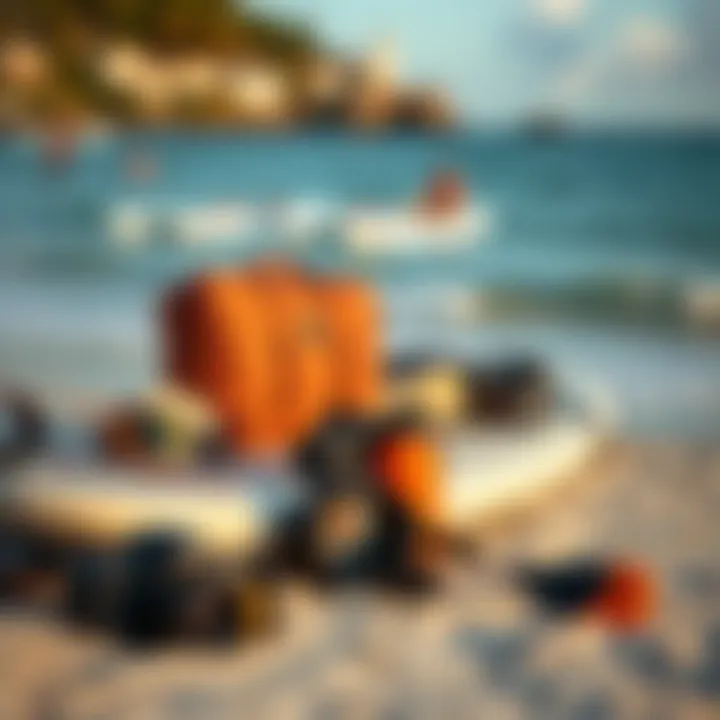
For those who enjoy a bit of an adrenalin rush, the choppy water challenge is the way to go. It's about paddling through rough waters while showcasing control and skill. To take on this challenge:
- Find a body of water with small to moderate chop.
- Maintain a low center of gravity by keeping your knees bent and your feet planted firmly on the board.
- Use shorter, more frequent strokes to navigate through the waves, steering your board more actively.
- Practice making quick transitions and adjustments to stay upright and balanced.
This trick not only enhances your paddling technique but also prepares you for unpredictable conditions. Mastery of the choppy water challenge breeds confidence that can be transferred to other adventures on water.
Embracing these advanced tricks allows paddlers to invite new dimensions to their skills, turning paddle boarding from a leisurely pastime into an engaging sport full of achievements and growth.
Essential Equipment for Paddle Board Tricks
When it comes to paddle boarding, having the right equipment can make all the difference. The waves won't be kind to you if you show up without proper gear. Think of it as the backbone of your performance, enhancing not just your tricks but also your overall safety and enjoyment on the water.
Choosing the Right Paddle Board
Selecting the right paddle board is crucial. Not all boards are created equal; some are designed for stability while others are built for speed or trick performance. A wider board, for instance, will provide more stability, which is essential for executing advanced tricks like the nose ride or a pivot turn. On the other hand, a narrower board might sacrifice stability for speed, impacting your balance during complex movements.
Consider the type of paddle boarding you wish to engage in: flatwater, surfing, or racing. A paddle board suited for each of these activities varies significantly. For example, if you’re focused on tricks, look for boards that are thicker with a flatter bottom. These boards allow for greater maneuverability and help you maintain your balance as you perfect those technical moves.
Paddle Selection and Its Impact on Performance
The paddle you choose matters as much as the board. It's your main tool for propulsion and stability, influencing your performance during tricks. A lightweight paddle can make a world of difference when it comes to agility. Paddles made from materials like carbon fiber provide strength without the heft, allowing for quicker turns and dynamic movements.
Moreover, the length of the paddle affects your strokes too. A longer paddle can give you reach when trying to stabilize in awkward positions, while a shorter paddle might offer more control during intricate maneuvers. It's like swinging a bat in baseball; the right length can enhance your game or send you tumbling into the water.
Wearing Appropriate Safety Gear
Never underestimate the significance of safety gear when you're out pounding the waves. Unless you want to become a candidate for a blooper reel, it's best to remain as protected as possible. Life jackets, especially, aren't just for beginners. These vests provide buoyancy and can come in handy during unforeseen circumstances. Moreover, wearing appropriate footwear helps in maintaining grip on your board, especially when you get soaked and slippery.
Helmets are also worth considering if you're venturing into trickier waters. They protect your noggin from unexpected falls, something that can happen during ambitious tricks. As the saying goes, "better safe than sorry"; taking precautions ensures that you can keep practicing without the added worry of injury.
The right equipment allows you to focus on mastering your tricks rather than worrying about safety or performance.
Combining these elements thoughtfully can lead you to become not just a better paddle boarder but also a more confident and skilled performer. Take time in choosing what suits you best, and you'll find that each paddle, board, and safety feature contributes significantly to your journey in mastering paddle board tricks.
Practicing Paddle Board Tricks Safely
Safety ranks as the foremost consideration when it comes to paddle board tricks. Engaging in any water sport carries inherent risks, yet with reasonable precautions, you can greatly minimize those dangers. Practicing paddle board tricks safely not only enhances your enjoyment on the water but also boosts your confidence in mastering new skills. Before embarking on your adventure, it's worthwhile to understand the nuances of safety in this thrilling discipline.
Identifying Safe Locations for Practice
Choosing the right spot to practice is crucial to ensuring safety while paddle boarding. Look for locations that are calm, with clear waters, and minimal boat traffic. Lakes with gentle waves or designated paddling zones are excellent, especially for beginners. Be on the lookout for weather patterns as well; choose a time when the wind is at its most gentle.
Some ideal practice locations include:
- Lakes: They often have calmer waters than oceans, making them perfect for practicing tricks.
- Marinas: These areas tend to be shielded from strong winds and currents.
- Designated Paddling Areas: Some coastlines have specific zones for paddle boarding, ensuring a safer experience.
Finding a safe space helps not just in avoiding hazardous conditions, but also makes the experience enjoyable as you focus on perfecting your techniques.
Understanding Weather Conditions
Weather can change quicker than you can say "paddle board." Being aware of the conditions before setting out is non-negotiable. Wind, rain, or sudden storms can turn a fun day into a dangerous one. Always check local forecasts for wind speed and directions, temperature changes, and possible storm warnings.
- Wind: An ideal day has light winds. Winds can knock you off balance. If it surpasses 10 mph, consider holding off.
- Rain: Although light rain may not be an issue, heavy downpours can create rough water and reduce visibility.
- Temperature: If the water is colder than 60°F, hypothermia may be a risk. In such cases, ensure you have a wetsuit.
Knowing the weather conditions can aid not just in keeping you safe, but also in optimizing your practice sessions.
Ensuring Proper Supervision and Spotting
When attempting new tricks, having a buddy or even a group provides both safety and camaraderie. A partner acts not only as a cheerleader but also as a lookout. Should an accident occur, they can provide assistance or alert someone onshore.
Here are some key points to consider regarding supervision:
- Training Together: During practice, a partner can help spot errors in technique that you may not notice, contributing to faster improvement.
- Emergency Plans: Having an agreement on signals or safety plans can make all the difference in potential mishaps.
- Communicate: Sharing your goals and boundaries with your partner ensures you're both on the same page.
Having the right supervision guarantees a smoother learning journey, allowing you to focus on mastering those paddle board tricks.
Staying safe not only protects you; it also encourages others in your community to join in the fun without fear.
Overall, the art of practicing paddle board tricks incorporates an essential mix of safety considerations. By identifying safe locations, understanding the weather, and ensuring proper supervision, you can enjoy this engaging sport while keeping yourself and others safe.
The Physical Benefits of Paddle Board Tricks
Paddle boarding isn’t just about cruising along calm waters or dropping some tricks for fun. It offers a whole suite of physical benefits that contribute to overall health and well-being. Engaging in paddle board tricks fosters a unique blend of cardio workouts, strength training, and mental challenges. Each time you step on that board, you’re not just maintaining your balance; you’re investing in your physical health.
Improving Cardiovascular Health
Engaging in paddle board tricks can be an excellent means to improve cardiovascular health. When performing various maneuvers—such as spins or sudden changes in direction—your heart rate spikes. This activity enhances blood circulation and strengthens the heart muscle. Here’s how it works:
- Increased Heart Rate: Trick-based paddle boarding pushes your body into a higher exertion zone compared to simple paddling. The pivots and turns require bursts of energy that get your heart racing.
- Endurance Building: Over time, these activities enhance aerobic capacity. As you practice, you’ll notice increased stamina not just on the water but in everyday activities too.
- Caloric Burn: All this action adds up, leading to considerable calorie expenditure, which is beneficial for weight management.
In simpler terms, when you practice paddle board tricks, you're likely sweating it out while giving your heart a workout, the essence of good cardio health.
Enhancing Muscular Strength
Paddle board tricks are also a formidable way to build strength. While it may look effortless, balancing on the board involves several muscle groups working in unison. Here’s the breakdown:
- Core Activation: Tricks force you to engage your core muscles for stability. A strong core supports good posture and balance, which is vital, especially during dynamic movements.
- Leg Strength: Your legs, particularly the quadriceps, hamstrings, and calves, get a significant workout as you shift your weight and navigate tricky moves.
- Upper Body Engagement: Paddling and supporting your frame while attempting tricks engages your shoulders and arms. This enhanced upper body strength is essential for effective paddling.
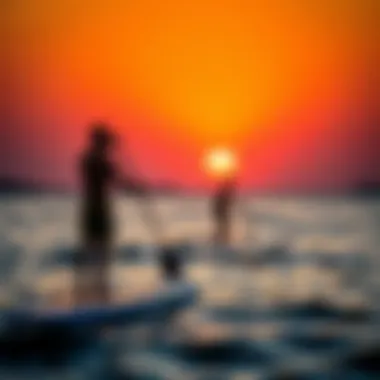
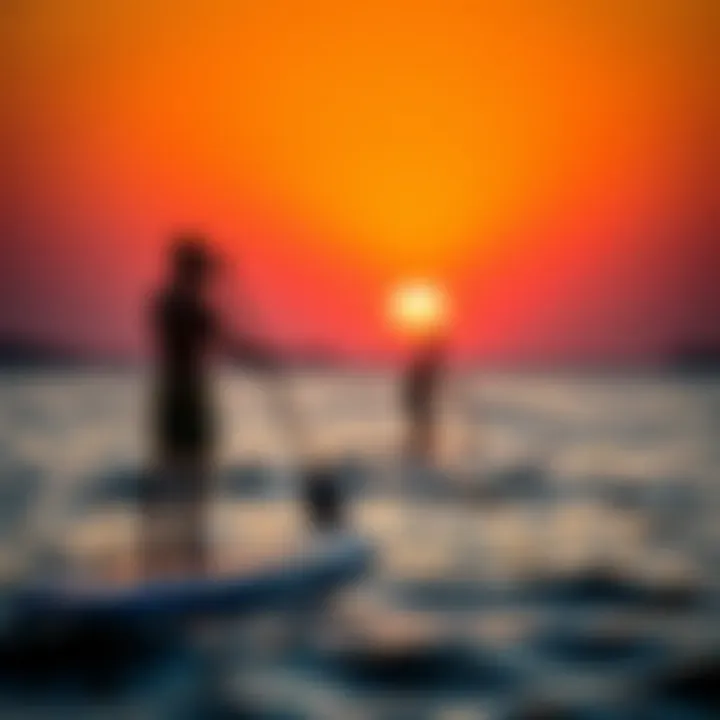
So, as you toast the art of balancing, your muscles are silently gaining strength, inching you toward improved performance in not just paddle boarding but other physical endeavors.
Boosting Mental Well-being
Paddle board tricks aren’t just about the body; the mind gets its rate of exercise too. Engaging in sports like paddle boarding contributes to improved mental health in various ways:
- Stress Reduction: The rhythmic motion of paddling combined with trick play enables the release of endorphins, those all-important happy hormones. This can combat stress and anxiety levels.
- Focus and Concentration: Attempting advanced tricks requires a good bit of concentration. This level of focus flows over into other spheres of life, boosting productivity as well.
- Mind-Body Connection: Navigating water while performing tricks creates a powerful connection between mind and body, improving mindfulness and helping you remain present.
"In every flip, every turn, the paddle board offers not just a challenge but also a form of mental liberation. It’s where physicality meets serenity."
In summary, paddle board tricks serve as a holistic approach to physical and mental wellness. They are not simply leisure activities but profound tools for health. Whether you're chasing after that perfect trick or simply enjoying the water, the benefits for your heart, muscles, and mind create a layered experience in the outdoor realm.
Tips for Progressing in Paddle Board Tricks
As you embark on your journey through the world of paddle board tricks, understanding how to progress effectively is crucial. This process is not merely about learning new moves; it encompasses a comprehensive approach that fosters continuous improvement and builds your confidence on the water. A thoughtful strategy can help you maximize your potential, ensuring that each session leaves you feeling accomplished rather than overwhelmed.
Setting Realistic Goals
Setting goals is akin to charting a course on an unmarked map; it gives direction to where you want to go. However, like trying to paddle against a strong current without a plan, unrealistic expectations can lead to frustration. Begin by identifying what specific trick or skill you wish to master. Break this down into smaller, manageable milestones. For instance, if you're aiming to conquer the nose ride, focus first on perfecting your foot placement and balance.
- Start with one trick at a time.
- Set deadlines that are reasonable based on your current skill level.
- Celebrate small victories, like successfully completing a pivot turn before moving onto more complex moves.
This method allows for incremental progress, making the learning process feel rewarding.
Recording Progress for Improvement
Keeping track of your advancements can make all the difference in your development. Recording your practice sessions—perhaps by taking notes or videos—provides insight into what works and what needs fine-tuning. It’s not just about capturing your successes; it’s equally about documenting the challenges you encounter.
- Use a journal to jot down key observations after each practice.
- Consider creating a video log; reviewing your technique can bring greater awareness to areas needing adjustment.
- Share this progression with fellow paddle boarders; their feedback can give you fresh perspectives.
This approach not only keeps you accountable but also makes you aware of improvements you might overlook in the heat of practice.
Learning from Failures and Setbacks
Every paddler has faced moments that feel like a trip into uncharted waters. It’s human to falter. Rather than viewing setbacks as roadblocks, consider them stepping stones. For example, if a trick doesn’t go as planned, take a moment to analyze what went wrong—was it your balance, your timing, or perhaps your paddle technique?
"Failure is simply the opportunity to begin again, this time more intelligently."
Embracing these fallbacks teaches resilience, a critical trait not only in paddle boarding but in life as well. Don’t be afraid to attempt a maneuver multiple times; persistence can eventually carve successes from setbacks.
By focusing on setting attainable goals, tracking your progress diligently, and learning from missteps, you create a robust framework for improvement in paddle boarding. This holistic approach lays the groundwork for a fulfilling, ongoing journey in mastering paddle board tricks.
Joining the Paddle Boarding Community
Engaging with the paddle boarding community goes beyond merely enjoying the sport; it unlocks a treasure trove of experiences, knowledge, and camaraderie. For paddlers, learning and perfecting tricks provide a sense of accomplishment, but sharing that journey with others amplifies the joy and dedication that comes with the sport. This connection with fellow enthusiasts fosters motivation and allows paddlers to learn from each other's successes and challenges.
Finding Local Clubs and Groups
The beauty of paddle boarding is that it's a versatile sport; you can do it solo, but teaming up can transform your experience. Finding local clubs or groups can be as easy as a quick search on community boards or social media platforms. Websites such as Facebook and Meetup have numerous paddle boarding groups that cater to all skill levels, from beginners to pros. Joining a group provides a support system where you can ask questions, exchange tips, and even coordinate group outings.
- Benefits of Joining Local Clubs:
- Access to experienced paddlers who can guide your skill development.
- Opportunities to participate in organized events or group outings.
- A chance to meet locals and form lasting friendships.
- Regular practice sessions which can help improve your balance and skill over time.
When you surround yourself with like-minded individuals, the sport becomes more enjoyable. These clubs often organize workshops that focus on specific tricks or techniques, providing a space where you can learn in a supportive environment.
Participating in Competitions and Events
For those looking to take their paddle boarding to the next level, competitions and events present excellent opportunities. Many local clubs host events ranging from friendly competitions to more formal challenges. Participating in these competitions enhances not only your skills but also your confidence and sense of achievement.
Engaging in competitive events allows you to:
- Test your skills against others in a controlled environment.
- Gain valuable insights into your strengths and areas for improvement.
- Meet a wider network of paddlers, creating opportunities for future practice and collaboration.
You'd be surprised how stepping out of your comfort zone can spark personal growth. Remember, it's all about progression, and competitions can be a powerful motivator to refine your tricks and showcase your abilities.
By joining the paddle boarding community, whether through clubs or events, you not only become part of a culture but enrich your journey in mastering paddle board tricks. The sense of belonging and shared passion can elevate your experience significantly, transforming you from a solitary paddler to an integral part of an enthusiastic community. > "It's not just about the tricks you learn, it's about the people you get to share them with."
For more resources and information on paddle boarding, feel free to explore Reddit's Paddleboarding Community or check out some local listings on Meetup.
Additionally, for safety tips and best practices, visit the American Canoe Association.
Embrace the journey of paddle boarding and let the community guide you towards mastering the art of balance and skill.
Closure: The Ongoing Journey of Mastering Paddle Board Tricks
As we draw the curtain on our adventure through the world of paddle board tricks, it becomes clear that this is not just a temporary challenge, but rather an endless voyage of learning and discovery. The evolution of one's skills on the water can be likened to building a solid foundation—each layer matters and contributes to the overall structure of your abilities. Mastering paddle board tricks is as much about the physical execution of techniques as it is about nurturing the mindset that embraces continuous improvement.
Reflections on Progress and Growth
Reflecting on your journey, it's vital to acknowledge how far you've come. Every time you stood on that board, you were not just practicing a trick; you were also developing resilience. The ups and downs faced along the way serve as invaluable teachers. Perhaps you've nailed the burpee or finally landed a perfect pivot turn; each success is a testimony of your commitment to progress. Recognizing the value of these achievements can reinforce your motivation.
Moreover, sharing your journey with fellow paddle boarders can be invigorating. Their experiences, both triumphs and stumbles, mirror your own. This sense of community fosters encouragement, pushing all participants toward higher aspirations and greater excitement about tackling new challenges.
Looking Ahead: Future Opportunities in Paddle Boarding
Looking beyond the present, the horizon of paddle boarding holds a wealth of future possibilities. New techniques and tricks continuously emerge, ensuring there is always something fresh to capture your imagination. Envisioning participation in competitions can further ignite your passion. They provide a platform not only to showcase your skills but also to learn from others and connect with those who share your love for the sport.
Additionally, consider broadening your paddle boarding repertoire—try out new styles such as paddle yoga or even racing. Each new dimension opens different avenues for growth and improvement, challenging your balance and skill in varying environments.
In essence, the journey of mastering paddle board tricks embodies a thoughtful balance of progression, camaraderie, and exploration.
"The art of paddle boarding is not merely in executing tricks but in embracing the journey of becoming a better version of oneself on the water."
As you paddle forward, remember that the waters may shift, but your commitment to evolution and exhilaration will keep you afloat.















